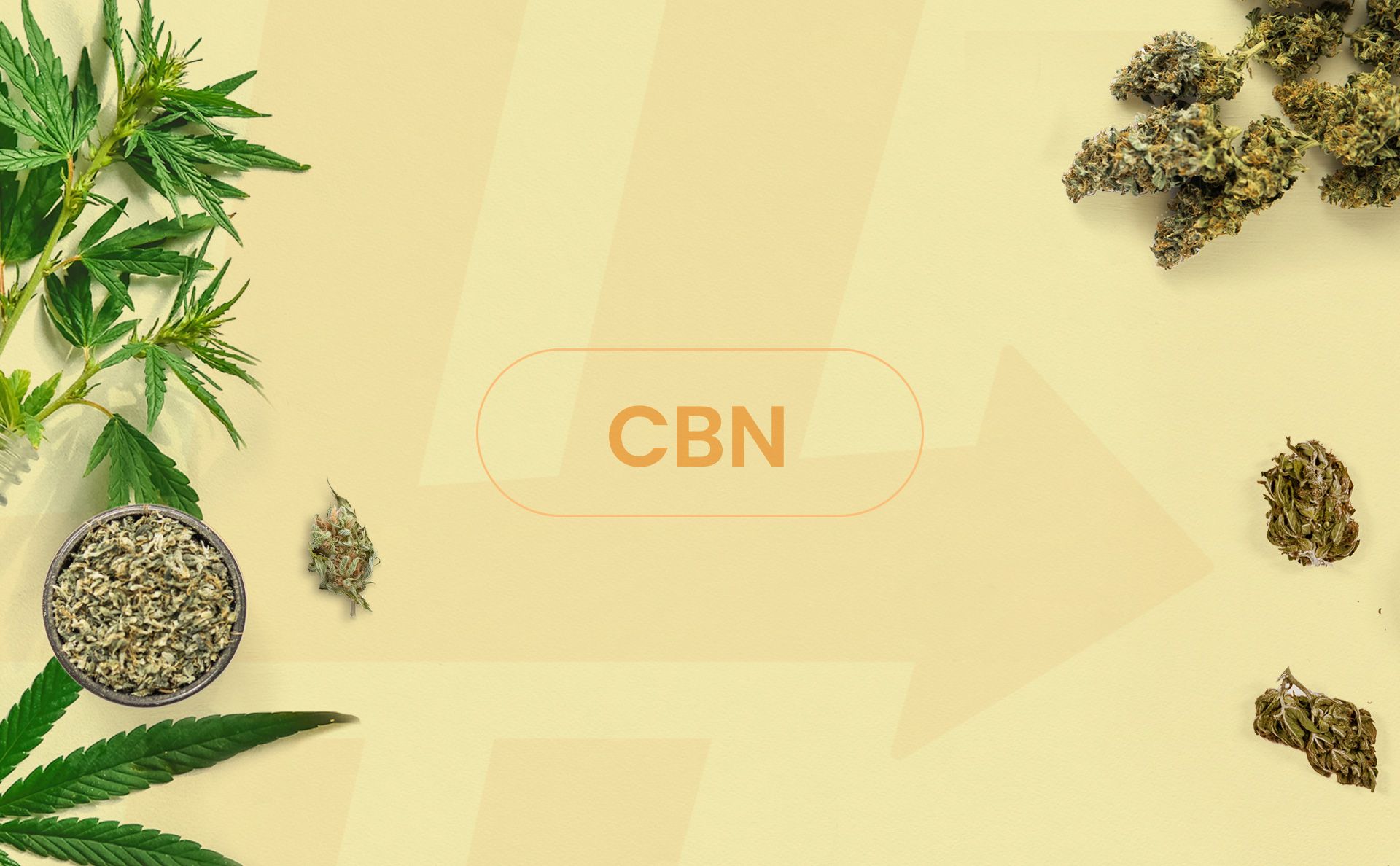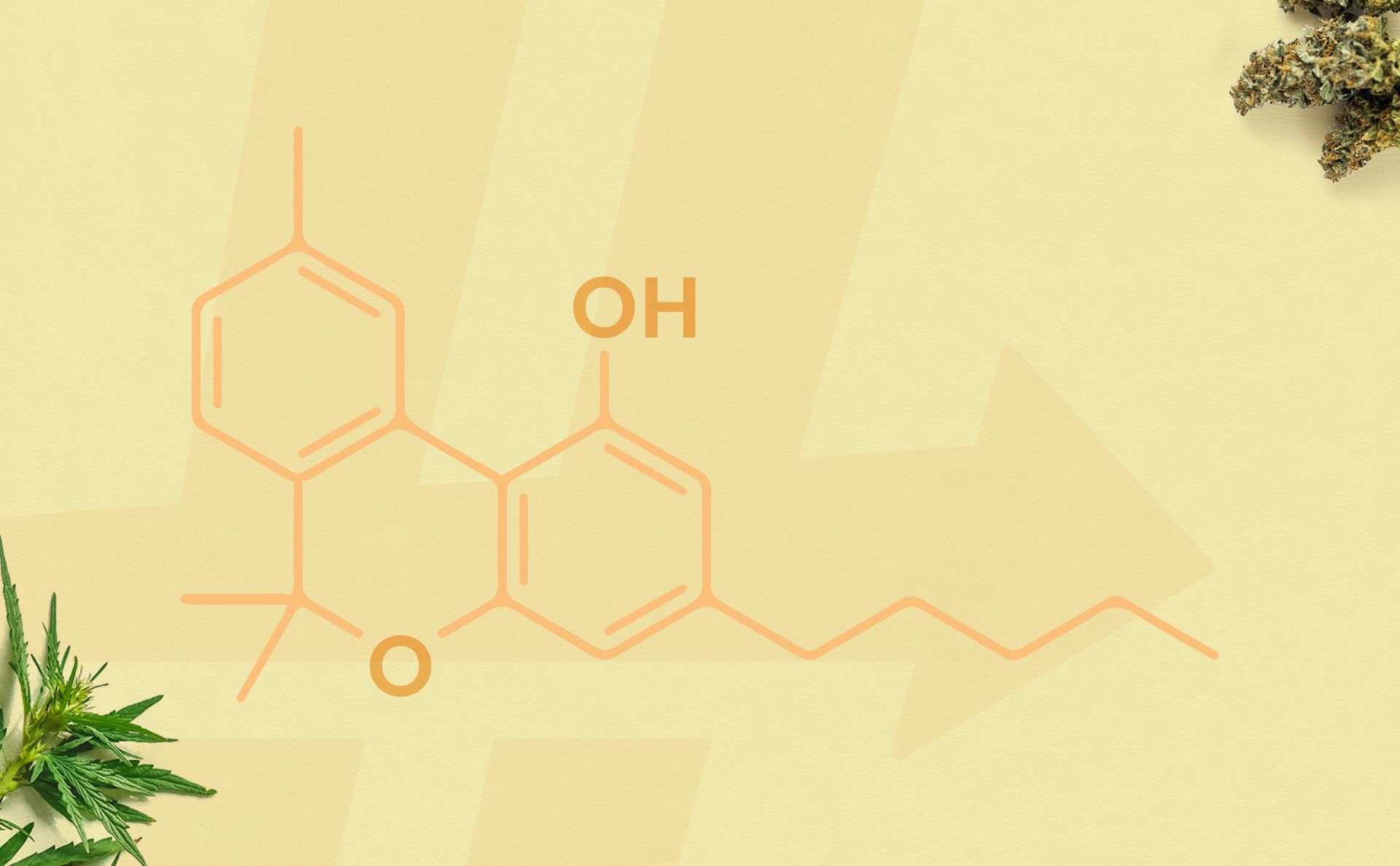CBN
What is CBN, does it get you high, and what are the potential benefits of this cannabinoid? We cover this and more right here.

What is CBN?
CBN, or cannabinol, is a cannabinoid with a mild psychoactive effect. While there can still be psychoactive effects from CBN, these are significantly less than that of THC. CBN can bind to CB1 receptors about 10 times less than THC, enough to produce a mild high in larger quantities.
That’s because CBN is directly derived from aged or oxidized THC. CBN is produced in the largest amounts when cannabis or hemp plants are aging, and have been exposed to oxygen and light. When this happens, the energy from light and heat causes tetrahydrocannabinol (THC) to lose four of its hydrogens and simply become cannabinol or CBN.
The largest amounts of CBN are produced when cannabis is left open to light and oxygen, and even happens under ideal storage conditions. However, we do not recommend leaving your cannabis flower out for a week or two to try this potentially beneficial cannabinoid. Instead, we recommend searching for this compound in a cannabis or hemp-derived full-spectrum (most favorable), broad-spectrum (THC-free), or isolate form.
As cannabis plants dry out after harvesting with age and curing, THC molecules slowly form into CBN. Because very little CBN is produced from fresh cannabis plants, isolating and utilizing this potentially useful compound is challenging. Although CBN was the first cannabinoid discovered way back in 1896, the compound has not been widely consumed because producing it is inefficient.

The time-consuming aspect of producing CBN has recently changed, thanks to the development of new extraction equipment and the advancement of production methods. These have become available to us, in large part because of federally legal hemp and cannabis markets expanding in many states.
Effects of CBN
Unlike CBD, CBN is weakly psychoactive. But it’s also unlike THC in that consuming CBN at the same doses likely won’t get you high or nearly as high.
Many canna-curious consumers of CBD and CBN products tell us, however, that they feel noticeable relief from these products. As such, this experience can be new to them, resulting in gentle relaxation and even euphoria, which may mimic mild effects of THC. There are very few clinical studies examining the side effects of CBN, with all of them indicating a milder high than Delta 9 THC.
This is largely backed up by an older study (1973) where high-dose CBN was given by IV. Participants were given as much CBN as they could “comfortably tolerate.” Surprisingly, they all tolerated it so well, none of them asked for the infusion to be turned off. The side effects were described as “mild and enjoyable.”

What the expert says...
Dr. Abraham Benavides
"CBN is produced from the natural breakdown of THC in Cannabis. This cannabinoid is mainly produced as cannabis and hemp plants age. It retains several of THC’s functions, but with a much milder experience."
Potential Benefits of CBN
Before CBN’s recent uptick in sales, the most common application for this compound was actually in archaeological studies. Because CBN is oxidized from THC, it is very stable and also helps prove historical or ancient cannabis use. The earliest studies were only looking into its psychoactive potential.
Nowadays, CBN is gaining much popularity as a natural sleep aid. While this news is certainly positive for those of us who have trouble sleeping, CBN might not be as effective as a natural sedative, especially at low doses as advertised.
The common misconception is that older cannabis is high in CBN, this cannabis makes consumers sleepy, and therefore CBN is a natural sleep aid. The fact is that THC is more of a sedative than CBN, but the two of them put together may be best for sleep. However, more unbiased studies on the potential sleep aid benefits of CBN are necessary.
Given the paucity of clinical research on CBN, there is still decent preclinical evidence to suggest the following areas are promising and worth looking into:
- Chronic pain, including fibromyalgia, myofascial, and TMDs
- Appetite stimulant
- Anti-inflammatory and antioxidant
- Neuroprotective, with potential application for Alzheimer's, Huntington's, and Parkinson's
- Allergic airway disease
- A rare, peeling skin disorder called epidermolysis bullosa
- Anticonvulsant
- Anti-cancer effects on glioma (brain), liver, and breast cancer cells
- Glaucoma
- Antibacterial
- Stimulating bone formation
- Insomnia and sleep disorders, likely best with THC
What We Learned: CBN
CBN is yet another cannabinoid with healing potential that has been underserved by the mainstream. Here’s what we learned about CBN:
- CBN, or cannabinol, is a cannabinoid with a mild psychoactive effect.
- While there can still be psychoactive effects from CBN, these are roughly ten times less than that of THC.
- In large quantities, CBN can produce a mild high
- Canna-curious consumers of CBD and CBN products may feel noticeable symptomatic relief from these products.
- As such, this experience can be new to them, resulting in gentle relaxation and even euphoria, which may mimic mild effects of THC.
- CBN is produced in the largest amounts when cannabis or hemp plants are aging and are exposed to oxygen, heat, or light.
- THC will convert to CBN even under ideal storage conditions, so don't take it personally.
- Production of products with CBN has recently increased, thanks to legalization efforts leading to the development of new extraction equipment and the advancement of production methods.
- CBN products are touted as a sleep aid, often mixed with other ingredients aimed at promoting rest and relaxation. These marketing claims aren’t necessarily true.
- In general when it comes to sleep-inducing effects, the combination of THC and CBN is greater than THC alone, which is much greater than CBN.
- There are some preclinical and few clinical studies to support its safety and tolerability, as well as its potential therapeutic applications for a number of conditions, especially those involving inflammation and neuroprotection.
As is the case with all things cannabis, we are only barely scratching the surface when it comes to understanding the benefits of cannabinoids like CBN. The future is bright for the legal cannabis industry, and HashDash will be there to answer your questions every step of the way.
Speaking of which, you’re getting closer to completing our Cannabinoids Guide. Excellent work. Get the below question right and keep moving!
Citations
- Corroon, J. (2021). Cannabinol and Sleep: Separating Fact from Fiction. Cannabis and Cannabinoid Research, 6(5), 366–371.https://doi.org/10.1089/can.2021.0006
- Liang, Z., Soriano-Castell, D., Kepchia, D., Duggan, B. M., Currais, A., Schubert, D., & Maher, P. (2022). Cannabinol inhibits oxytosis/ferroptosis by directly targeting mitochondria independently of cannabinoid receptors. Free Radical Biology and Medicinhttps://doi.org/10.1016/j.freeradbiomed.2022.01.001
- Maioli, C., Mattoteia, D., Amin, H. I. M., Minassi, A., & Caprioglio, D. (2022). Cannabinol: History, Syntheses, and Biological Profile of the Greatest “Minor” Cannabinoid. Plants, 11(21), 2896.https://doi.org/10.3390/plants11212896
- Passani, A., Posarelli, C., Sframeli, A. T., Perciballi, L., Pellegrini, M., Guidi, G., & Figus, M. (2020). Cannabinoids in Glaucoma Patients: The Never-Ending Story. Journal of Clinical Medicine, 9(12), 3978.https://doi.org/10.3390/jcm9123978
- Russo, E. B. (2011). Taming THC: Potential cannabis synergy and phytocannabinoid-terpenoid entourage effects. British Journal of Pharmacology, 163(7), 1344–1364.https://doi.org/10.1111/j.1476-5381.2011.01238.x
- Somvanshi, R. K., Zou, S., Kadhim, S., Padania, S., Hsu, E., & Kumar, U. (2022). Cannabinol modulates neuroprotection and intraocular pressure: A potential multi-target therapeutic intervention for glaucoma. Biochimica et Biophysica Acta (BBA) - Molecularhttps://doi.org/10.1016/j.bbadis.2021.166325
- Walsh, K. B., McKinney, A. E., & Holmes, A. E. (2021). Minor Cannabinoids: Biosynthesis, Molecular Pharmacology and Potential Therapeutic Uses. Frontiers in Pharmacology, 12, 777804.https://doi.org/10.3389/fphar.2021.777804
- Zhong, N., Li, D., Wang, B., Kovalchuk, O., & Kovalchuk, I. (2023). Cannabinol inhibits cell growth and triggers cell cycle arrest and apoptosis in cancer cells. Biocatalysis and Agricultural Biotechnology, 48, 102627.https://doi.org/10.1016/j.bcab.2023.102627
Test your knowledge, track your progress and earn your badge.
CBN is non-psychoactive.

Dr. Abraham Benavides
Dr. Abraham Benavides is an internationally-recognized cannabis research expert, experienced medical advisor, and full-tuition merit scholar of the George Washington University School of Medicine and Health Sciences. Dr. Abe enjoys helping patients as a writer, educator, and cannabis health coach at the GW Center for Integrative Medicine.